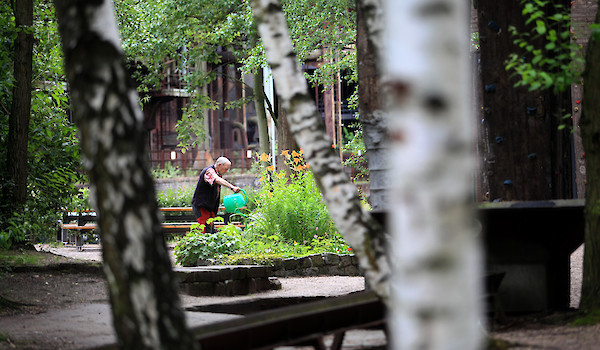Parklands
The Parklands at the Landscape Park are a place for all sorts of local recreation. Whether as a venue for major events or simply as a leisure park – there’s something here for everyone.

So-called “Open Space Planning” is an important component of the Municipal Development Plan for the planned redevelopment of non-built-up areas. Open Space Planning, also known as landscape architecture, is to be understood as an aesthetic and artistic discipline which creates, on a scientific and technical basis, living space sensitive to ecological and social factors. An example of this is the endeavour to achieve a balanced relationship in major cities between residential areas and open spaces. In seeking to create living space, landscape architecture relies on the use of dynamic means – often natural components such as hedges, trees and ground cover. For this reason a landscape architecture project is never truly finished, but a concept in development.
By Landschaftspark one means in general a park or garden, a landscape which has been reshaped on the basis of certain landscape architectural plans. It is only since the International Building Exhibition Emscher Park (IBA) that a redeveloped industrial landscape has been classified as a Landschaftspark Duisburg-Nord.
In the case of a redeveloped industrial landscape, a Landschaftspark functions on the principles of urban development with regard to ecological, social and cultural factors. It confronts the challenges of structural change and entails the restoration of nature.
Over an extended period of time one tries to restore nature’s own cycles to full working order on an industrial site. But this reconstruction of the landscape is not a return to a previous state, but rather letting nature take the lead. In a post-industrial Landschaftspark what’s already there is to be preserved, space is to be created and nature and culture developed.
The replanted and maintained open spaces and gardens in the Landschaftspark Duisburg-Nord have been designed on the basis of specific ideas inherent to landscape architecture. The Sinter Gardens, the Stadtrandgarten and the farmers’ gardens on the farm at Ingenhammshof are examples of just such gardens. But the rock gardens in the Storage Bunkers are very different, where nature is taking over again in the “wild chambers”. The visitor, following paths and traversing boardwalks, will gain a good look down into the Sinter Plant’s hoppers, planted with lavender, silver camomile and other plants, and the charge bunkers where vegetation has grown wild. The planted and maintained Stadtrandgarten consists of three sections: a garden with herbaceous perennials; a fruit orchard; and a wildflower garden where specimens from the site have been left to self-seed and colonise. The farmers’ gardens on the farm at Ingenhammshof have been laid out on the basis of an old French model – separate beds with flowers, herbs, vegetables bordered by box hedges in the parterre style. The pretty picture of the garden is rounded off with watering places.
The work and especially the landscape architecture in the Landschaftspark Duisburg-Nord entails far-reaching ecological issues which can be applied to the Open Space Planning of the whole Ruhr District. Investment in the environment and the issue of sustainable economic activity are important points in the ecological renewal of a contaminated site. During the course of the International Building Exhibition, for example, work began on the ecological remodelling of the Emscher system, work for two generations but which has pointed the way forward in terms of creating living space in the Ruhr District.